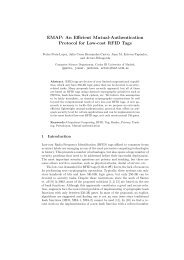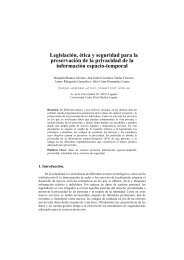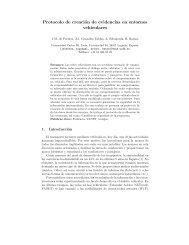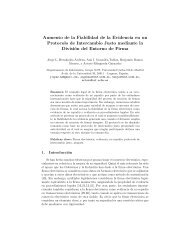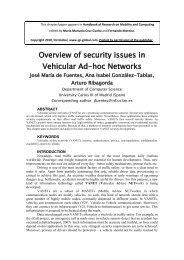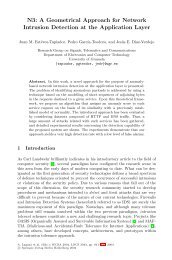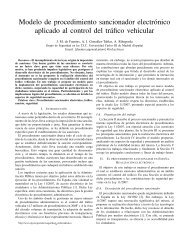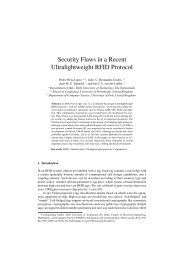Metaheuristic Traceability Attack against SLMAP, an RFID ...
Metaheuristic Traceability Attack against SLMAP, an RFID ...
Metaheuristic Traceability Attack against SLMAP, an RFID ...
Create successful ePaper yourself
Turn your PDF publications into a flip-book with our unique Google optimized e-Paper software.
May 6, 2010 14:16 WSPC/INSTRUCTION FILE<br />
IJFCS˙<strong>Attack</strong>ing<strong>SLMAP</strong>˙CameraReady<br />
<strong>Metaheuristic</strong> <strong>Traceability</strong> <strong>Attack</strong> <strong>against</strong> <strong>SLMAP</strong>, <strong>an</strong> <strong>RFID</strong><br />
Lightweight Authentication Protocol<br />
Julio Cesar Hern<strong>an</strong>dez-Castro ∗<br />
School of Computing, Portsmouth University, Portsmouth, UK<br />
Julio.Hern<strong>an</strong>dez-Castro@port.ac.uk<br />
Ju<strong>an</strong> M<strong>an</strong>uel Estevez-Tapiador<br />
Department of Computer Science, University of York, York, UK<br />
jet@cs.york.ac.uk<br />
Pedro Peris-Lopez<br />
Information & Communication Theory Group, Delft University, Delft, The Nederl<strong>an</strong>ds<br />
P.PerisLopez@tudelft.nl<br />
John A. Clark<br />
Department of Computer Science, University of York, York, UK<br />
jac@cs.york.ac.uk<br />
El-Ghazali Talbi<br />
INRIA Futurs, Villeneuve d’Ascq, Lille, Fr<strong>an</strong>ce<br />
& King Saud University, Riyadh, Saudi Arabia<br />
El-ghazali.Talbi@lifl.fr<br />
Received (Day Month Year)<br />
Accepted (Day Month Year)<br />
Communicated by (xxxxxxxxxx)<br />
We present a metaheuristic-based attack <strong>against</strong> the traceability of <strong>an</strong> ultra-lightweight<br />
authentication protocol for <strong>RFID</strong> environments called <strong>SLMAP</strong>, <strong>an</strong>d <strong>an</strong>alyze its implications.<br />
The main interest of our approach is that it constitutes a complete black-box<br />
technique that does not make <strong>an</strong>y assumptions on the components of the underlying<br />
protocol <strong>an</strong>d c<strong>an</strong> thus be easily generalized to <strong>an</strong>alyze m<strong>an</strong>y other proposals.<br />
1. Introduction<br />
The idea of attacking cryptographic protocols by me<strong>an</strong>s of metaheuristic procedures<br />
is relatively new. Two very relev<strong>an</strong>t works in this area are that of Knudsen et al.<br />
[1] <strong>an</strong>d that of Clark et al. [2], where the authors were the first to use various<br />
∗ Corresponding author.<br />
1
May 6, 2010 14:16 WSPC/INSTRUCTION FILE<br />
IJFCS˙<strong>Attack</strong>ing<strong>SLMAP</strong>˙CameraReady<br />
2<br />
heuristic techniques for protocol crypt<strong>an</strong>alysis. Even though these results had quite<br />
<strong>an</strong> impact on the security of Identification Protocols, they both were more focused<br />
on solving the underlying NP-hard problem (the Permuted Perceptron Problem,<br />
PPP [7]) th<strong>an</strong> in addressing the protocol itself.<br />
There is also a more recent but quite preliminary work [5] of some interest but<br />
limited relev<strong>an</strong>ce because its authors were only able of crypt<strong>an</strong>alysing a toy protocol<br />
(a scaled-down <strong>an</strong>d simplified version of SASI [6]). Conversely, the related area of<br />
evolving or automatically designing cryptographic protocols by me<strong>an</strong>s of different<br />
heuristic techniques has seen considerable success too, <strong>an</strong>d some notable (<strong>an</strong>d even<br />
hum<strong>an</strong> competitive) results have been already attained [3, 4].<br />
The rest of the paper is org<strong>an</strong>ized as follows. In the next section, we present a<br />
general model for the metaheuristic attack on cryptographic protocols. After this,<br />
in Section 3 we describe a recently proposed authentication protocol for <strong>RFID</strong><br />
environments called <strong>SLMAP</strong>, which could be attacked as described in Section 4.<br />
Finally, in Section 5 we draw some conclusions <strong>an</strong>d propose possible improvements<br />
together with future research lines.<br />
2. General <strong>Attack</strong> Model<br />
The main idea behind our approach is to tr<strong>an</strong>sform the crypt<strong>an</strong>alysis of a security<br />
protocol into a search problem, where a large number of different search metaheuristics<br />
c<strong>an</strong> be applied. In general, during this search we will try to find which are the<br />
secret state values (keys, nonces, etc.) of some subset of the parties involved in the<br />
protocol.<br />
This, of course, could be done in various ways, but the most natural approach<br />
(while seriously limited a ) is to measure the cost of the tentative set of secret values<br />
by the proximity b of the messages produced by these tentative solutions to the real<br />
public messages generated <strong>an</strong>d exch<strong>an</strong>ged during the actual protocol execution.<br />
Most cryptographic protocols should exch<strong>an</strong>ge one or more messages to accomplish<br />
their intended objective(s) (authentication, key exch<strong>an</strong>ge, key agreement, etc.),<br />
<strong>an</strong>d in the vast majority of cases these messages are sent via <strong>an</strong> insecure or public<br />
ch<strong>an</strong>nel that c<strong>an</strong> be easily snooped.<br />
In our attack model, the crypt<strong>an</strong>alyst will generally try to infer the secret values<br />
that the two parties intend to hide by exploiting the knowledge of the exch<strong>an</strong>ged<br />
messages. In a robust, secure, well-designed cryptographic protocol, even states that<br />
are very close to the real state should not produce messages that are very close (for<br />
<strong>an</strong>y useful dist<strong>an</strong>ce definition) of the real public messages. This should be done,<br />
typically, by me<strong>an</strong>s of a careful design <strong>an</strong>d message construction based on the use<br />
a Protocols could be explicitly designed to make this task impossible or much harder by being<br />
m<strong>an</strong>y-to-one, in the sense of allowing a large number of possible secret states to exch<strong>an</strong>ge exactly<br />
the same public messages during a protocol execution, but this seems not to be the case in most<br />
recent ultra-lightweight authentication proposals.<br />
b This will usually be measured by the cost function guiding the metaheuristic search.
May 6, 2010 14:16 WSPC/INSTRUCTION FILE<br />
IJFCS˙<strong>Attack</strong>ing<strong>SLMAP</strong>˙CameraReady<br />
3<br />
of some highly-nonlinear cryptographic primitives such as block ciphers or hash<br />
functions.<br />
Unfortunately, new proposals in the field of lightweight cryptography, which are<br />
intended towards very computationally constrained environments (such as low-cost<br />
<strong>RFID</strong> systems) c<strong>an</strong>not use classical cryptographic primitives such as hash functions<br />
[12]. That implies that m<strong>an</strong>y of the blossoming ultra-lightweight authentication protocols<br />
that are currently being proposed could be potentially open to attacks based<br />
in metaheuristic search that would be much harder to mount had these proposals<br />
been armed with classical cryptographic algorithms. In addition to this, m<strong>an</strong>y of<br />
these new protocol proposals are supposed to offer new security services that are far<br />
from the classical ones, including some that are not yet well understood <strong>an</strong>d even<br />
lack <strong>an</strong> un<strong>an</strong>imously accepted definition by the security community (i.e. traceability<br />
[11]). That only makes things harder for protocol designers, <strong>an</strong>d more unlikely for<br />
their proposals to be secure enough to be deployed.<br />
3. Description of the <strong>SLMAP</strong> protocol<br />
In 2007, Li <strong>an</strong>d W<strong>an</strong>g proposed a very interesting ultra-lightweight mutual authentication<br />
protocol intended for very low-cost <strong>RFID</strong> tags [8]. This protocol was called<br />
<strong>SLMAP</strong> <strong>an</strong>d only used very efficient operations, such as bitwise XOR <strong>an</strong>d addition<br />
mod 2 96 . It avoided using costly operations such as multiplication, hash computation<br />
or exponentiation (as there is the common assumption that they c<strong>an</strong>not<br />
be carried out over low-cost <strong>RFID</strong> tags) <strong>an</strong>d the generation of r<strong>an</strong>dom numbers<br />
(nonces) was performed by the <strong>RFID</strong> reader (generally assumed not to have severe<br />
computational limitations).<br />
The <strong>SLMAP</strong> protocol is briefly described in the following, where R represents<br />
a reader, T represents a tag, IDS m st<strong>an</strong>ds for <strong>an</strong> index pseudonym in session m,<br />
ID is tag’s private ID, Ki<br />
m represent tag’s secret keys during session m, <strong>an</strong>d r is a<br />
nonce. All variables have a 96-bit length.<br />
(1) R → T : hello<br />
(2) T → R : IDS m<br />
(3) With IDS m , the reader finds in the backend database the tag’s secret values<br />
ID, K m 1 , <strong>an</strong>d K m 2 .<br />
(4) R generates nonce r to construct messages A <strong>an</strong>d B as follows<br />
A = IDS m ⊕ K1<br />
m<br />
B = IDS m + K2<br />
m<br />
+ r<br />
⊕ r<br />
where ⊕ st<strong>an</strong>ds for the usual bitwise addition modulo 2, + represents addi-
May 6, 2010 14:16 WSPC/INSTRUCTION FILE<br />
IJFCS˙<strong>Attack</strong>ing<strong>SLMAP</strong>˙CameraReady<br />
4<br />
tion modulo 2 96 , <strong>an</strong>d the ⊕ operation is assumed to have a higher precedence<br />
th<strong>an</strong> modular addition. The reader sends to the tag the concatenation of A <strong>an</strong>d<br />
B<br />
R → T : A‖B<br />
(5) From A <strong>an</strong>d B the tag c<strong>an</strong> obtain the value of r <strong>an</strong>d verify that the reader<br />
knows K1<br />
m <strong>an</strong>d K2 m . Then it locally computes C <strong>an</strong>d sends its value.<br />
T → R : C with<br />
C = (IDS m + ID ⊕ r) ⊕ (K m 1 + r) ⊕ (K m 2 + r)<br />
where ID is the tag secret ID, only known to him <strong>an</strong>d authorized readers,<br />
a const<strong>an</strong>t value typically set at the m<strong>an</strong>ufacturing stage which c<strong>an</strong>not be<br />
tr<strong>an</strong>smitted in clear because this will allow for trivial traceability attacks. It is<br />
thus the value IDS, or index pseudonym, which ch<strong>an</strong>ges in a seemingly r<strong>an</strong>dom<br />
fashion after each authentication session to difficult tracking attacks.<br />
(6) R verifies C <strong>an</strong>d, if it is equal to the result of its local computation, updates<br />
IDS m , K m 1 <strong>an</strong>d K m 2 , <strong>an</strong>d computes <strong>an</strong>d sends D:<br />
IDS m+1 = (IDS m + K1<br />
m ⊕ r + (ID + K2 m )) ⊕ r<br />
K1 m+1 = K1 m ⊕ r + (IDS m+1 + K2 m + ID)<br />
K2 m+1 = K2 m ⊕ r + (IDS m+1 + K1 m + ID)<br />
R → T : D with<br />
D = IDS m+1 ⊕ (ID + r) + (K m 1 ⊕ K m 2 ⊕ r)<br />
To the best of our knowledge, <strong>SLMAP</strong> has received no attacks yet. As is usually<br />
the case with ultra-lightweight authentication protocols designed for very resource<br />
constrained environments, it is intended to be at least secure <strong>against</strong> passive attacks.<br />
Much more powerful active attacks would probably be possible, although<br />
these are generally precluded in the definition of most of proposals [14, 15, 16]. We<br />
focus, then, on passive attacks because these directly question the security objectives<br />
of the protocol, <strong>an</strong>d simult<strong>an</strong>eously make the weakest assumptions about the<br />
attacker capabilities. Passive attacks are also clearly least risky for the attacker,<br />
since interference may otherwise be detected.<br />
4. Crypt<strong>an</strong>alysis of the <strong>SLMAP</strong> protocol<br />
After eavesdropping one single session, <strong>an</strong>y attacker will have access to the values<br />
IDS, A, B, C, D exch<strong>an</strong>ged during this session. As the description of the <strong>SLMAP</strong>
May 6, 2010 14:16 WSPC/INSTRUCTION FILE<br />
IJFCS˙<strong>Attack</strong>ing<strong>SLMAP</strong>˙CameraReady<br />
5<br />
algorithm is public, we c<strong>an</strong> start from a r<strong>an</strong>dom set of secret values {K ′ 1, K ′ 2, r ′ , ID ′ }<br />
<strong>an</strong>d run the protocol over them to see what messages A ′ , B ′ , C ′ , D ′ do they generate.<br />
Then, using a metaheuristic technique, we c<strong>an</strong> search for those that minimize<br />
the dist<strong>an</strong>ce between the c<strong>an</strong>didate <strong>an</strong>d the real exch<strong>an</strong>ged messages. In this case,<br />
we will use a Simulated Annealing technique, which is a metaheuristic technique<br />
that is extremely efficient <strong>an</strong>d has some ability to avoid becoming quickly trapped<br />
in local minima.<br />
As <strong>an</strong> additional justification for the use of this approach, we c<strong>an</strong> mention that<br />
it was the one employed in all three relev<strong>an</strong>t works in the area [1, 2, 5] published to<br />
date.<br />
4.1. Cost Function<br />
Different definitions of the cost function have been tried, <strong>an</strong>d the most successful<br />
was, by far:<br />
i=N<br />
∑<br />
f S = wt(M i ⊕ A i ) · 96 3−i (1)<br />
i=0<br />
where M i st<strong>an</strong>ds for the real (snooped) message <strong>an</strong>d A i is its approximation as<br />
computed from the values of c<strong>an</strong>didate state S.<br />
For our particular problem, equation (1) has the following form:<br />
∑i=3<br />
f S = wt(M i ⊕ A i ) · 96 i<br />
i=0<br />
= wt(M 3 ⊕ A 3 ) + wt(M 2 ⊕ A 2 ) · 96<br />
+ wt(M 1 ⊕ A 1 ) · 96 2 + wt(M 0 ⊕ A 0 ) · 96 3<br />
Where wt(·) st<strong>an</strong>ds for the Hamming weight.<br />
It is import<strong>an</strong>t to note here that, according to the definition presented in [2],<br />
the use of this straightforward cost function will not correspond to the application<br />
of what authors name a warping technique. The correct set of secret values will<br />
always lead to a global minimum.<br />
This is a quite simple cost function that reflects the intuitive idea of establishing<br />
a kind of lexicographical order between the dist<strong>an</strong>ces of the generated messages A’,<br />
B’, C’ <strong>an</strong>d D’ to those observed in the actual protocol run. The general strategy<br />
here is to try to force that the first generated message A’, should be really very<br />
close to the real one A, <strong>an</strong>d in fact in m<strong>an</strong>y cases we obtained a Hamming dist<strong>an</strong>ce<br />
of zero between the two. Then, we should look for very good approximations to B,<br />
<strong>an</strong>d only when stalled in this process we will start to refine the value of C’. With the<br />
parameter setting shown in Table 1, in most of the cases the Simulated Annealing<br />
algorithm did not had time to properly work on minimizing the dist<strong>an</strong>ce between<br />
D’ <strong>an</strong>d D.
May 6, 2010 14:16 WSPC/INSTRUCTION FILE<br />
IJFCS˙<strong>Attack</strong>ing<strong>SLMAP</strong>˙CameraReady<br />
6<br />
Table 1. SA parameters for tracing <strong>SLMAP</strong><br />
Initial Temperature 10<br />
Cooling Rate 0.9<br />
Max. Failed Cycles ∞<br />
Moves at Temperature 500<br />
Final Temperature 2 −5<br />
For this reason, we believe that it is very likely that higher values for the number<br />
of moves at a given temperature, together with a larger cooling rate <strong>an</strong>d initial<br />
temperature will, at the cost of some efficiency, lead to better results. Probably, less<br />
direct approaches will also work well, especially the use of warping techniques. In<br />
this particular case, however, the most simple formulation worked sufficiently well<br />
so we did not were tempted to introduce <strong>an</strong>y unnecessary complexity.<br />
4.2. Predicting the IDS<br />
The approach for forecasting the value of IDS is, then, to use a Simulated Annealing<br />
heuristic for trying to minimize the cost function <strong>an</strong>d only then use the best seen<br />
values of the secret state {K ′ 1, K ′ 2, r ′ , ID ′ } to run a <strong>SLMAP</strong> protocol over them <strong>an</strong>d<br />
see what value they predict for the IDS in the next authentication session.<br />
After extensive experimentation, a set of parameters was found to be a fair<br />
compromise between efficiency (the SA algorithm will be employed m<strong>an</strong>y times)<br />
<strong>an</strong>d efficacy. These are given in Table 1.<br />
One import<strong>an</strong>t characteristic of our attack is that it is successful after eavesdropping<br />
only one authentication session, which is a very economic requirement<br />
compared with those of other passive attacks.<br />
We have performed multiple simulations for measuring the effectiveness of this<br />
approach. In all the cases, we initialized all secret <strong>an</strong>d public values of the protocol<br />
to r<strong>an</strong>dom values generated with the Mersenne Twister [13] pseudor<strong>an</strong>dom number<br />
generator.<br />
The last element needed to run the Simulated Annealing algorithm over the<br />
<strong>SLMAP</strong> protocol is a neighborhood definition. The source code in Python of our<br />
neighborhood implementation is shown in the following:<br />
def neighbour(I):<br />
L=[I[0], I[1], I[2], I[3], I[4]]<br />
for i in r<strong>an</strong>ge(1,3):<br />
index=r<strong>an</strong>dint(1,4)<br />
pos=r<strong>an</strong>dint(0,96)<br />
L[index]=L[index]^(1
May 6, 2010 14:16 WSPC/INSTRUCTION FILE<br />
IJFCS˙<strong>Attack</strong>ing<strong>SLMAP</strong>˙CameraReady<br />
7<br />
We have run 20 experiments, each one consisting in 50 Simulated Annealing<br />
executions to try minimize the cost function described in Equation (1).<br />
If a forecast algorithm is not working on this particular problem, <strong>an</strong>d<br />
because of the simplest probabilistic arguments, we c<strong>an</strong> expect around 50 ·<br />
P {Binomial(96, 0.5) ≤ 48} ≃ 0.5406 · 50 ≃ 27.03 of these SA runs to find a good<br />
(i.e. at a Hamming dist<strong>an</strong>ce of 96<br />
2<br />
= 48) or below <strong>an</strong>d, around 22.97 of them finding<br />
bad ones (i.e. at a Hamming dist<strong>an</strong>ce strictly higher th<strong>an</strong> 48).<br />
Any statistically signific<strong>an</strong>t departure from this behavior me<strong>an</strong>s the metaheuristic<br />
search is being successful, <strong>an</strong>d this is exactly what we have observed in our experiments.<br />
The number of good approximations was consistently (through all the 20<br />
experiments) <strong>an</strong>d signific<strong>an</strong>tly (average of 40.3 instead of 27) better that expected.<br />
When in each of the 20 experiments we computed the majority vector of the<br />
50 approximations, this vector was always quite a good approximation of the real<br />
IDS value, having <strong>an</strong> average of 57.25 correct bits over the 48 correct bits that one<br />
should expect from a r<strong>an</strong>dom approximation. Some of these results are shown in<br />
Table 2.<br />
4.3. <strong>Traceability</strong> <strong>Attack</strong><br />
4.3.1. The Model<br />
The good approximations to the next IDS tag value obtained in the described way<br />
c<strong>an</strong> be exploited to mount a traceability attack, following the untraceability definition<br />
as proposed by Juels <strong>an</strong>d Weis [9], <strong>an</strong>d later used by Ph<strong>an</strong> in his attack <strong>against</strong><br />
SASI [10].<br />
This untraceability model is briefly described in the following, where we will<br />
restrict ourselves to passive attacks:<br />
• Adversary A interacts with a set of tags T <strong>an</strong>d readers R<br />
• He c<strong>an</strong> perform the Execute(R,T,i) query that allows him, by me<strong>an</strong>s of eavesdropping,<br />
to get access to a honest execution of the protocol session i between<br />
reader R <strong>an</strong>d tag T<br />
• He c<strong>an</strong> also perform a Test(i,T 0 ,T 1 ) query to mount <strong>an</strong> untraceability test.<br />
After executing this query, depending of a r<strong>an</strong>dom bit b ∈ {0, 1} the attacker<br />
A is given IDS b ∈ {IDS 0 , IDS 1 } corresponding to tags {T 0 , T 1 }. The attacker<br />
succeeds if he c<strong>an</strong> guess the r<strong>an</strong>dom bit b with a probability better th<strong>an</strong> flipping<br />
<strong>an</strong> unbiased coin.<br />
• This probability determines Avd UNT<br />
A (k), where k is a security parameter generally<br />
depending on the length of the secret state, <strong>an</strong>d could be expressed as<br />
Avd UNT<br />
A (k) = |P r[A guesses b correctly] − 1 2 |<br />
• We say that <strong>an</strong> <strong>RFID</strong> protocol achieves untraceability (UNT) if<br />
Avd UNT<br />
A (k) < ε(k)
May 6, 2010 14:16 WSPC/INSTRUCTION FILE<br />
IJFCS˙<strong>Attack</strong>ing<strong>SLMAP</strong>˙CameraReady<br />
8<br />
Table 2. <strong>Attack</strong> results for 20 runs, after observing 1 auth. session<br />
Exp. + Approx. - Approx. Correct bits Corr. R<strong>an</strong>d. Corr. Exp. Result<br />
1 46 4 60 0.23591 -0.00532 Success<br />
2 37 13 60 0.24760 -0.08020 Success<br />
3 36 14 53 0.10418 0.02094 Success<br />
4 39 11 56 0.13681 -0.01610 Success<br />
5 44 6 59 0.22518 -0.03496 Success<br />
6 34 16 53 0.10919 -0.12903 Success<br />
7 41 9 56 0.17157 0.12330 Success<br />
8 43 7 62 0.29247 0.08456 Success<br />
9 45 5 60 0.24967 -0.06447 Success<br />
10 42 8 58 0.19593 0.19375 Success<br />
11 44 6 58 0.21009 0.0994 Success<br />
12 35 15 53 0.10707 -0.11736 Success<br />
13 38 12 53 0.09923 -0.02172 Success<br />
14 47 3 61 0.26238 -0.04895 Success<br />
15 35 15 53 0.10629 0.14811 Fail<br />
16 47 3 66 0.36751 -0.16724 Success<br />
17 44 6 59 0.21093 0.03115 Success<br />
18 39 11 55 0.14885 0.08340 Success<br />
19 31 19 52 0.10013 -0.01543 Success<br />
20 39 11 58 0.20798 0.03845 Success<br />
Averages 40.3 9.7 57.25 0.19 0.01 ≈ 95% Success<br />
for some negligible function ε(x)<br />
4.3.2. Results<br />
It is clear that under this model (<strong>an</strong>d under <strong>an</strong>y other reasonable one, for that<br />
matter) the <strong>SLMAP</strong> protocol does not achieve untraceability, which is one of the<br />
main aims of <strong>RFID</strong> protocols to avoid tracking attacks.<br />
For seeing this, it suffices to observe that once the attacker A has performed<br />
<strong>an</strong> Execute(R,T,i) query <strong>an</strong>d, as a result of this, has eavesdropped the values of<br />
messages A, B, C <strong>an</strong>d D he c<strong>an</strong> launch the metaheuristic attack as proposed in<br />
Section 4 to obtain m<strong>an</strong>y good approximations to the next IDS value.<br />
After that, by performing a Test(i,T 0 ,T 1 ) query he will be able to compute the
May 6, 2010 14:16 WSPC/INSTRUCTION FILE<br />
IJFCS˙<strong>Attack</strong>ing<strong>SLMAP</strong>˙CameraReady<br />
9<br />
correlation c between his approximations <strong>an</strong>d the two values {IDS 0 , IDS 1 }, knowing<br />
that higher values will likely correspond to that of the eavesdropped tag.<br />
We have carried out this attack to approximate the value of Avd UNT<br />
A (k), <strong>an</strong>d<br />
heuristically (over 20 experiments) obtained a success probability of around 95%,<br />
which implies a non negligible attacker adv<strong>an</strong>tage of around 0.95-0.5=0.45. The<br />
average correlation between the IDS of the eavesdropped tag <strong>an</strong>d the majority<br />
vector after a metaheuristic run was of 0.19, while that between the approximation<br />
<strong>an</strong>d <strong>an</strong>other r<strong>an</strong>dom IDS was, as expected, very close to zero (0.01). These results<br />
are depicted in Table 2.<br />
It c<strong>an</strong> be seen that, although no approximation is perfect, all of them are much<br />
closer to the real IDS value th<strong>an</strong> what would have been expected at r<strong>an</strong>dom. Combining<br />
all these approximations into a system of equations for obtaining even a<br />
closer value to the IDS is, although not technically very challenging, left for future<br />
works.<br />
Each of the 50 run experiments takes approximately 30 minutes in a very modest<br />
portable computer. They are completely parallelizable.<br />
4.3.3. Discussion<br />
It is remarkable that all the correlations measured between the real IDS value <strong>an</strong>d<br />
that obtained after launching the metaheuristic algorithm (a simulated <strong>an</strong>nealing in<br />
this case) are positive, indicating that there is actually a successful learning process.<br />
On the other h<strong>an</strong>d, roughly one half between the correlations computed between<br />
the IDS <strong>an</strong>d r<strong>an</strong>dom values are, as expected, negative. This apparently makes easy<br />
for this attack scheme to produce <strong>an</strong>d attacker adv<strong>an</strong>tage greater to zero, but things<br />
are not so simple. Firstly, always producing approximations with a positive correlation<br />
value is far from trivial. Most natural <strong>an</strong>d intuitive cost functions fail to achieve<br />
even this which, one should note, is neither a sufficient nor a necessary condition<br />
for a successful attack.<br />
Furthermore, for achieving a success ratio signific<strong>an</strong>tly higher that a 75%, it<br />
is necessary not only to steadily construct positive correlated outputs, but also to<br />
get them more correlated with the IDS value th<strong>an</strong> expected from positive r<strong>an</strong>dom<br />
correlated values (i.e. |ρ 0 | > ρ 1 around 75% of the times).<br />
For <strong>SLMAP</strong>, it is not so difficult to find other cost functions that lead to a nonnegligible<br />
attacker adv<strong>an</strong>tage, but in very few cases this adv<strong>an</strong>tage is larger th<strong>an</strong> 1 4<br />
(corresponding to the 75% ratio).<br />
c We refer here to the Pearson or centered correlation between two binary vectors, measured as<br />
their cosine once they have been centered to have a zero average, i.e.<br />
corr(A, B) = cos ÂB =<br />
x · y<br />
‖x‖ · ‖y‖<br />
(2)
May 6, 2010 14:16 WSPC/INSTRUCTION FILE<br />
IJFCS˙<strong>Attack</strong>ing<strong>SLMAP</strong>˙CameraReady<br />
10<br />
4.3.4. <strong>Traceability</strong> Pseudocode<br />
The general traceability attack algorithm is described in Figure 2.<br />
0. Snoop a <strong>SLMAP</strong> run between Tag T 0 <strong>an</strong>d R, get IDS n , A, B, C, D<br />
1. For i = 0 to 50<br />
2. Start a Simulated Annealing process to minimise f S<br />
3. Run <strong>SLMAP</strong> over the values obtained in 2.<br />
4. Compute approx. for IDS n+1 <strong>an</strong>d store in ListIDS<br />
5. Compute MajIDS, the Majority Vector of all members of ListIDS<br />
6. Get c<strong>an</strong>didate values for IDS n+1 , IDS 0 <strong>an</strong>d IDS 1<br />
7. Compute correlation of these values with MajIDS, ρ 0 <strong>an</strong>d ρ 1<br />
8. If ρ 0 > ρ 1 then IDS n+1 =IDS 0 else IDS n+1 =IDS 1<br />
Fig. 2. Outline of the traceability attack.<br />
5. Concluding Remarks<br />
In this paper we have presented a very efficient <strong>an</strong>d effective black-box attack<br />
<strong>against</strong> a novel <strong>an</strong>d quite interesting ultra-lightweight authentication protocol called<br />
<strong>SLMAP</strong>.<br />
This attack is implemented by using a non-st<strong>an</strong>dard crypt<strong>an</strong>alytic technique<br />
based on the use of a Simulated Annealing algorithm, which is able of setting up a<br />
traceability attack with a quite high success probability (around 95%). We, however,<br />
make no optimality claim whatsoever, <strong>an</strong>d believe that even better traceability<br />
attacks could be mounted by refining the presented black-box technique, either by<br />
a slight ch<strong>an</strong>ge in the SA parameters, or possibly even by <strong>an</strong> alternative <strong>an</strong>alytic<br />
formulation.<br />
Studying other lightweight protocols like SASI [6] with similar techniques is a future<br />
<strong>an</strong>d interesting research direction. Another promising research line is to mount<br />
similar attacks not only <strong>against</strong> the traceability property of a security protocol, but<br />
<strong>against</strong> more classical security objectives such as their secrecy or authentication<br />
capabilities, possibly by trying to recover the value of the secret identifier of the<br />
tag (ID), which is the value all the protocols are designed to conceal. This will be<br />
considered in future works.<br />
References<br />
[1] Lars R. Knudsen <strong>an</strong>d Willi Meier. “Crypt<strong>an</strong>alysis of <strong>an</strong> Identification Scheme Based<br />
on the Permuted Perceptron Problem” In Adv<strong>an</strong>ces in Cryptology - EUROCRYPT<br />
1999, LNCS 1592, pp. 363–374. Springer-Verlag, 1999.<br />
[2] John A. Clark <strong>an</strong>d Jeremy L Jacob. “Fault Injection <strong>an</strong>d a Timing Ch<strong>an</strong>nel on <strong>an</strong><br />
Analysis Technique”. In Adv<strong>an</strong>ces in Cryptology - EUROCRYPT 2002, LNCS 2332,<br />
pp. 181–196. Springer-Verlag, 2002.
May 6, 2010 14:16 WSPC/INSTRUCTION FILE<br />
IJFCS˙<strong>Attack</strong>ing<strong>SLMAP</strong>˙CameraReady<br />
11<br />
[3] John A. Clark <strong>an</strong>d Jeremy L Jacob. “Protocols are Programs Too: the Meta-heuristic<br />
Search for Security Protocols”. Special Issue on Metheuristics for Software Engineering.<br />
Information Software Technology 43(14):891-904, December (2001).<br />
[4] Hao Chen, John A. Clark, Jeremy Jacob. “Hum<strong>an</strong> competitive security protocols<br />
synthesis”. Proceedings of the 8th <strong>an</strong>nual conference on Genetic <strong>an</strong>d evolutionary<br />
computation (GECCO 2006), pp. 1855–1856.<br />
[5] Julio Cesar Hern<strong>an</strong>dez-Castro, Ju<strong>an</strong> M. Estevez-Tapiador, Arturo Ribagorda: “Nonst<strong>an</strong>dard<br />
<strong>Attack</strong>s <strong>against</strong> Cryptographic Protocols, with <strong>an</strong> Example over a Simplified<br />
Mutual Authentication Protocol”. MCO 2008, pp. 589–596.<br />
[6] Hung-Yu Chien. “SASI: A New Ultralightweight <strong>RFID</strong> Authentication Protocol Providing<br />
Strong Authentication <strong>an</strong>d Strong Integrity”. IEEE Tr<strong>an</strong>sactions on Dependable<br />
<strong>an</strong>d Secure Computing 4(4):337–340, Oct.-Dec. 2007.<br />
[7] David Pointcheval. “A New Identification Scheme Based on the Perceptron Problems.”<br />
In Adv<strong>an</strong>ces in Cryptology - EUROCRYPT 1995. LNCS 2199. Springer-Verlag,<br />
1995<br />
[8] Tiey<strong>an</strong> Li, Guilin W<strong>an</strong>g. “<strong>SLMAP</strong> - A Secure ultra-Lightweight <strong>RFID</strong> Mutual Authentication<br />
Protocol”. In Proceedings of Chinacrypt’07, Oct. 19-22, 2007. Cheng Du,<br />
China.<br />
[9] A. Juels <strong>an</strong>d S.A. Weis. “Defining Strong Privacy for <strong>RFID</strong>”. Proceedings of IEEE<br />
PerCom’07, pp. 342–347, 2007. Full version available at IACR ePrint Archive,<br />
http://eprint.iacr.org/2006/137, 7 April 2006.<br />
[10] Raphael C. Ph<strong>an</strong>. “Crypt<strong>an</strong>alysis of a New Ultralightweight <strong>RFID</strong> Authentication<br />
Protocol - SASI”. IEEE Tr<strong>an</strong>sactions on Dependable <strong>an</strong>d Secure Computing. 2008.<br />
[11] Ton v<strong>an</strong> Deursen <strong>an</strong>d Sasa Radomirovic. “On a New Formal Proof Model for <strong>RFID</strong><br />
Location Privacy”. Cryptology ePrint Archive: Report 2008/477. Available online at<br />
http://eprint.iacr.org/2008/477.<br />
[12] A. Bogd<strong>an</strong>ov, G. Le<strong>an</strong>der, C. Paar, A. Poschm<strong>an</strong>n, M. Robshaw, <strong>an</strong>d Y. Seurin.<br />
“Hash Functions <strong>an</strong>d <strong>RFID</strong> Tags: Mind the Gap”. E. Oswald <strong>an</strong>d P. Rohatgi (Eds.):<br />
CHES 2008, LNCS 5154, pp. 283–299. Springer-Verlag, 2008.<br />
[13] Makoto Matsumoto, Takuji Nishimura. “Mersenne twister: a 623-dimensionally<br />
equidistributed uniform pseudo-r<strong>an</strong>dom number generator”. ACM Tr<strong>an</strong>sactions on<br />
Modeling <strong>an</strong>d Computer Simulation (TOMACS), 8(1):3–30, J<strong>an</strong>. 1998.<br />
[14] S. Karthikey<strong>an</strong> <strong>an</strong>d M. Nesterenko. “<strong>RFID</strong> Security without Extensive Cryptography”.<br />
In Proc. of SASN’05, 2005.<br />
[15] D. Nguyen Duc, J. Park, H. Lee, <strong>an</strong>d Kw<strong>an</strong>gjo K. “Enh<strong>an</strong>cing security of EPCglobal<br />
Gen-2 <strong>RFID</strong> tag <strong>against</strong> traceability <strong>an</strong>d cloning”. In Proc. of Symposium on Cryptography<br />
<strong>an</strong>d Information Security, 2006.<br />
[16] Y. Cui, K. Kobara, K. Matsuura, <strong>an</strong>d H. Imai. “Lightweight asymmetric privacypreserving<br />
Authentication protocols secure <strong>against</strong> active attacks”. In Proc. of Per-<br />
Sec’07. IEEE Computer Society, 2007.



